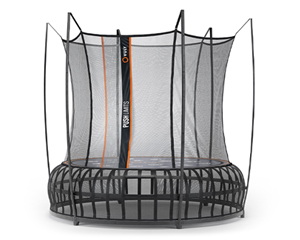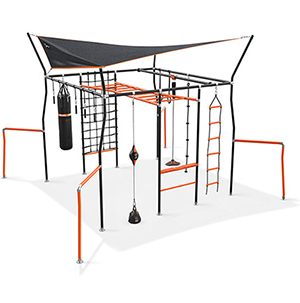1. Tag/Tiggy
Tag, also known as Tiggy, is a timeless outdoor game that children across generations have enjoyed. The simplicity of this game is what makes it popular among kids. All you need is an open space where children can run around freely.
The basic concept of Tag revolves around one player being "it" and attempting to tag other players. Once the "it" player tags someone, that person becomes the new "it" and the game continues. There is no need for any equipment or additional rules, making it an easy game to play during recess or at parties.
Tag can also be played on the playground, where the vertical aspect of the play equipment can bring a new level of excitement to the game.

2. Tug of War
Tug of War is a classic outdoor game that has been enjoyed by generations of kids. It's a simple game that requires little equipment, making it perfect for large groups and backyard parties. The game consists of two teams holding opposite ends of a long rope, with the objective of pulling the other team across a designated line.
The first step to organizing a game of Tug of War is to gather the necessary equipment. You'll need a sturdy rope, ideally about 50 feet in length (15m), and a way to mark the center of the rope and the ground. The center of the rope can be marked with a brightly colored tape or fabric, while the ground can be marked using cones, flags, or even just a line drawn in the dirt.
Before the game begins, make sure to divide the kids into two evenly-matched teams. You should base this on age and size. Encourage the children to communicate and work together as they position themselves along the rope, with the strongest players in the middle and lighter players at the end.
When the game starts, each team tries their best to pull the opposing team towards them, using their strength and teamwork to move the center marker across the designated line. The game continues until one team successfully pulls the other team across the line!
3. Monkey in the Middle
Monkey in the Middle is a classic outdoor game designed for three or more players. The objective of the game is for the "monkey" in the middle to intercept the ball being tossed between the other players. This simple yet engaging game helps in developing children's motor skills, hand-eye coordination, and social interaction.
To play Monkey in the Middle, gather a group of three or more players and choose a soft ball, such as a foam ball. Designate one player as the "monkey" and position them in between two other players. These two players will toss the ball back and forth, attempting to prevent the "monkey" from intercepting the ball. The "monkey" must try to catch or tag the ball during the pass. If the "monkey" successfully captures the ball, the player who made the last unsuccessful pass becomes the new "monkey" in the middle.
Monkey in the Middle can be easily adapted to suit a variety of ages and skill levels. For younger players, you can decrease the distance between the players or use a larger, slower-moving ball. For older children or more advanced players, consider increasing the distance and challenging them with a smaller, faster ball.
This game can also be played on a trampoline, making for a great trampoline game.

4. Capture the Flag
Capture the flag is a classic outdoor game that promotes teamwork and physical activity among kids. The game is generally played with at least six players, divided into two teams. Each team has their own flag placed at their base, and the primary objective is to capture the opponent's flag and bring it back to their own base.
The game is typically played in an open area. It encourages children to work together and improve their problem-solving skills. At its core, capture the flag is an ideal combination of physical and mental challenge, making it an excellent choice for kids of different ages and skill levels. Additionally, the game can be easily adapted for larger groups or smaller spaces by adding variations and modifications.
To start a game of capture the flag, designate a playing area and create two defined zones – one for each team. Mark the boundaries using cones or other visible markers, and then place a flag prominently within each team's zone.
The players then strategize to infiltrate the opposing team's territory, capture their flag, and return it to their base without being tagged by the opposing team members. If tagged, players go to 'jail', a designated space in the opponent team's base where they must remain until rescued by a teammate.
5. The Floor is Lava Game
The Floor is Lava Game is a popular and active game that promotes physical activity among children and can be played both indoors and outdoors. This game has its origins in the imaginative play of jumping from one piece of furniture to another in order to avoid touching the floor, which is imagined as hot, molten lava.
To set up the game, several objects or pieces of furniture are strategically placed around the play area. These can include milk crates, stools, and dining room chairs, or anything else that is safe for kids to step or jump onto. The goal is for players to move from one side of the play area to the other without touching the floor.
The game can also be played outside on a playground, monkey bars set, or can be played with a Tag element where kids need to chase each other while avoiding the ground.

6. Hopscotch
Hopscotch is a classic and timeless outdoor game that has been enjoyed by children around the world for generations. It's easy to set up and play, making it a great choice for kids of all ages. The traditional hopscotch layout consists of a series of chalk-drawn numbered squares on the ground, and players take turns hopping through the squares on one foot while avoiding certain designated squares.
The game requires a combination of balance, coordination, and strategic thinking. One of the key aspects of hopscotch is the use of a small object, often called a "marker" or "tossing stone," which players throw into a square before beginning their turn. The player must then hop through the squares while avoiding the square with the marker. The goal is to successfully complete the course and then pick up the marker on the way back, without stepping on any lines or losing balance.
There are many variations of hopscotch that children can enjoy playing. These variations can introduce new challenges and rules, keeping the game interesting and engaging for both new and experienced players.

7. Forty Forty Home
Forty Forty Home is a thrilling outdoor game that can be enjoyed by kids of various ages. It combines elements of hide and seek with the excitement of trying to reach a "home" base before getting caught. This game encourages physical activity and teamwork amongst the participants and can be played in a wide range of outdoor settings.
To set up the game, first designate a home base that serves as a safe spot for the players. This could be a tree, a post, or any other landmark. Next, select one player to be the "seeker" whose task is to find and tag the other players. The seeker stands near the home base, closes their eyes and counts to a predetermined number, usually between 20 and 50, allowing the other players to hide.
Once the seeker completes counting, they must begin searching for the hidden players. The goal for the hidden players is to reach the home base without being tagged by the seeker. If a player is tagged, they're out of the game. Meanwhile, the seeker must keep an eye on the home base so that the hidden players do not sneak past and reach it without the seeker noticing.
The game continues until either all players are tagged, or one player successfully makes it to the home base. In the latter case, the first player to reach home is declared the winner and typically becomes the seeker in the next round.

8. Hide And Seek
Hide and Seek is a classic outdoor game that has been loved by children for generations. The simplicity of the game, combined with the excitement of finding the perfect hiding spot, makes it an all-time favorite activity for kids of all ages.
The game begins by selecting one person as the "seeker." The seeker closes their eyes and counts out loud, typically to a predetermined number, giving the other players time to find hiding spots. Once the counting is completed, the seeker begins their search for the hidden players. The goal of the game is to avoid being found by the seeker, and the last player remaining hidden is declared the winner.
9. Sardines
Sardines is a fun variation of hide and seek, offering an interesting twist for children looking for exciting outdoor games. Suited for two or more players, it can be played in any outdoor setting and is straightforward to set up and play.
To begin, one player is chosen to be "it" and hides while the other participants count to 30. After they've finished counting, they call out a phrase such as "coming ready or not!" and proceed to search for the person who is hiding.
The intriguing aspect of Sardines is that when a player finds the person hiding, instead of announcing their discovery, they quietly join the hiding spot. Gradually, more players find the hiding spot and join the others, hence the name "Sardines," as they all cram together like sardines in a can.
The game ends when only one player remains searching for the hidden group. The last person to find the others becomes "it" in the next round. This reversal of the hide-and-seek mechanics provides a fresh perspective and keeps the game engaging for children.

10. Octopus Game
The Octopus Game is a fun and engaging outdoor activity that can be enjoyed by kids of all ages. This game promotes physical activity and teamwork while providing a challenging and enjoyable experience for everyone involved.
In the Octopus Game, players are divided into two groups: the octopus and the rest of the players. The octopus stands in the middle of the play area, and the other players line up at one end. The goal of the game is for the players to make it from one end of the play area to the other without being tagged by the octopus. Usually, this is played in a confined space such as a basketball court.
When the game starts, the octopus calls out "Octopus!" and the players must run to the other side of the play area while trying to avoid being tagged. If a player is tagged by the octopus, they become seaweed and must stay in place. 'Seaweed' players use their arms to tag other players trying to run past them in subsequent rounds, but cannot move their feet.
As the game progresses, there will be less space for players to avoid the octopus and seaweed army as more players become tagged. The game continues until all players have been tagged and there is only one player left. The last remaining player is declared the winner.
11. Fruit Salad Game
The Fruit Salad Game is an entertaining and easy-to-learn outdoor kids' game that requires little preparation. It serves as an excellent icebreaker and is enjoyable for participants of all ages source.
To play the game, have the children sit in a circle and assign each player one of three fruits, for example - apples, oranges, or pears. Take turns going around the circle to allow each child to know their designated fruit. Once all players have their assigned fruit, one player stands in the center of the circle and shouts the name of a fruit.
When a fruit name is called, all children assigned that fruit must quickly stand up and change places. While the children are changing places, the player in the center tries to claim one of the available spots. The player left without a seat then becomes the caller in the center of the circle for the next round.

12. Simon Says
Simon Says is a classic outdoor game that is loved by children of all ages. In this game, one player takes on the role of "Simon," who gives instructions to the other players. The key to winning is to follow the instructions only when the phrase "Simon says" precedes the command. If a player follows the instruction without "Simon says" being mentioned, they're out of the game.
This game is suitable for groups of kids and can be played in any open space such as a park, backyard, or playground. Simon Says helps develop children's listening and concentration skills, making it an engaging and educational activity.
To play Simon Says, gather the children in a circle or a line, facing the designated "Simon." The game starts when "Simon" issues a command, such as "Simon says jump up and down." All players must follow the instructions as long as "Simon says" is spoken beforehand. For example, if "Simon" says, "Touch your nose" without using the phrase "Simon says," the players should not follow the command. Those who do are eliminated. The game continues until only one player remains, who then becomes the new "Simon."

13. Chinese Whispers
Chinese Whispers, also known as the Broken Telephone Game, is a popular and entertaining outdoor game that can be played by kids of all ages. This traditional game has been enjoyed for generations and continues to be a favorite at parties and group gatherings.
To play Chinese Whispers, participants form a circle or a straight line. One person starts the game by whispering a phrase or sentence into the ear of the person standing next to them. Each person then, in turn, whispers the message they have just heard to their neighbor, trying their best to relay the information accurately. The final player in the circle announces the message they received out loud, revealing the often comically distorted version of the original statement.
There are several benefits to children playing Chinese Whispers. It encourages listening skills, concentration, and memory retention. Furthermore, this game fosters teamwork and cooperation, as players strive to preserve the accuracy of the message throughout the chain.
14. Musical Chairs
Musical chairs is a classic party game that has stood the test of time and continues to be a favorite among children. This simple yet engaging game can be enjoyed by kids of all ages in any outdoor setting, making it a perfect addition to your list of best outdoor games for kids.
To set up the game, arrange chairs in two rows back to back, with one less chair than the total number of players. As the music plays, children must walk around the chairs, and when the music stops, they must quickly find a chair to sit on. Remove a chair each time the music stops, and the child who fails to find a seat is eliminated. The last child with a seat is declared the winner.

15. Duck Duck Goose
Duck Duck Goose is a timeless and exciting outdoor game that has entertained children for generations. It encourages physical activity, social interaction, and friendly competition. The game is easy to set up and can be played with a group of kids in various settings, such as backyards, parks, or school playgrounds.
To play Duck Duck Goose, all players sit in a circle facing inward. One player is chosen as the "it" and begins walking around the outside of the circle. As the "it" walks, they gently tap the heads of the other players, naming each one a "duck" until they decide to call someone a "goose."
Once the "goose" is selected, that player quickly stands up and tries to catch the "it" before they can run around the circle and sit in the now-empty spot. If the "it" manages to sit down before being caught, the "goose" becomes the new "it." Otherwise, the original "it" continues their role, and the game resumes.

16. Teepees And Indians Game
The Teepees and Indians game is a fun and engaging outdoor activity that brings the excitement of Native American culture to life for children. To play this game children are separated into 2 groups: teepees and Indians. The teepees stand with their legs apart while the Indians sit on the ground infront of them - creating a big circle. When 'teepees' are called they must run around the circle. When 'Indians' are called they must crawl through the 'teepees' legs and run around the circle.
In both cases, the last 'teepee' and 'Indian' team to make it back each round is eliminated.

17. Dodgeball
Dodgeball is a classic and popular outdoor game for kids that offers fun, excitement, and physical activity. It's a great way for kids to burn off energy while improving their coordination, agility, and teamwork skills. The game involves two teams aiming to eliminate opposing players by hitting them with a soft ball.
The traditional version of Dodgeball divides players into two teams on either side of a court or field, with a row of soft balls in the middle. When the game starts, players rush towards the center to grab a ball and throw it at the opposing team members. If a player is hit by a ball, they are eliminated from the game. However, if the player catches the ball, the thrower is out and one of the catcher's teammates can come back into the game.
Once all of players of one of the team's is eliminated the remaining team wins.
18. Dead Fish Game
Dead Fish is a simple and entertaining outdoor game for kids, which encourages them to test their abilities of staying still and maintaining a lifeless posture. The objective of the game is to remain as motionless as possible, imitating a dead fish. It can be played indoors as well, making it a versatile option for playtime.
To start the game, the leader counts down, giving the players a few seconds to get all their wiggles and laughs out. Once the countdown is over, the leader shouts "Dead Fish!", signaling the participants to assume their best lifeless poses. The leader then walks around, checking for movements or laughter. Those who break their 'dead fish' are eliminated from the game and the last person standing wins.
The Dead Fish game is ideal for various group sizes and age groups, as it requires no equipment and can be easily adjusted to accommodate different levels of difficulty. For instance, the leader can introduce challenges by introducing distractions or sudden loud noises to make it harder for players to keep a straight face.

19. Four Square
One of the most popular outdoor games for kids is Four Square. This game is suitable for children of all ages and requires minimal equipment - just a ball and a playing area divided into four small squares.
To play, each square is numbered, with the highest-numbered square being the 'king' position, the second highest - the 'queen' position, the third highest the 'jack', and the lowest position - 'dunce'. Often there is also a line of players waiting to enter the lowest position.
The game begins with the player in the 'king' square, serving the ball to another square by striking it with their hand. The receiving player must then return the ball to another square while keeping it inside the boundaries.
The objective is to advance to the highest-numbered square and maintain that position as long as possible. Players can be eliminated by failing to return the ball, double bouncing the ball in their own square, stepping out of bounds, or hitting the ball out of bounds. When a player is out, the remaining players move up to fill the spot, and a new player enters the game in the lowest-numbered square. If the 'king' is eliminated he moves to 'dunce' instead of going to the back of the line.

20. Gang Up Tiggy
Gang Up Tiggy is a thrilling and fast-paced outdoor game that builds on the classic game Tiggy or Tag.
To play Gang Up Tiggy, you'll need a group of children, an open outdoor area, and clear boundaries. One child is designated as "it" and must chase the other players in an attempt to tag them. Once a player is tagged, they become part of the "it" group, working together with the initial "it" to tag the remaining players.
As the game progresses, the "it" group grows larger, making it more challenging for the untagged players to evade capture. The game continues until all players have been tagged, and the last person caught becomes the new "it" for the next round.


















































